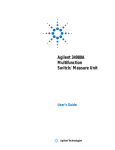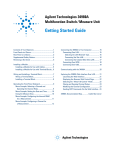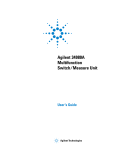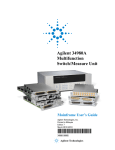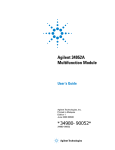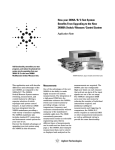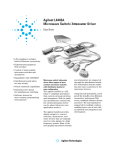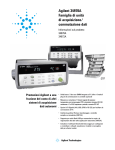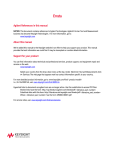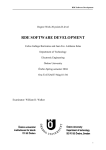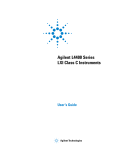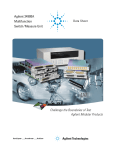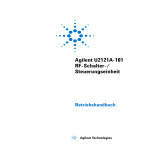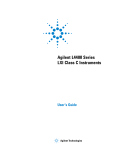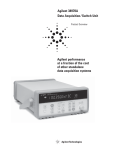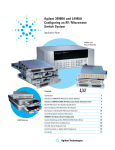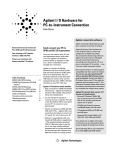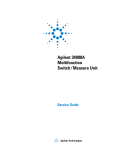Download Agilent Technologies 22A Specifications
Transcript
Agilent 34980A Multifunction Switch/Measure Unit Data Sheet C O N F I G U R E , C O N N E C T, G O • 8-slot mainframe with 19 mix-andmatch plug-in modules so you can create your own custom configuration • High-performance switching: Up to 560 2-wire multiplexer channels or 1024 matrix cross-points in one mainframe • Optional built-in 6 1 ⁄ 2 -digit DMM lets you make 11 measurements with up to 2000 readings/sec • Easy to integrate: Built-in Ethernet, USB 2.0, and GPIB connectivity, standard connectors and software drivers for most common programming environments High-performance unit provides low-cost alternative to PXI and VXI switch and measurement platforms If you use automated test equipment for design validation or manufacturing, you now have a cost-effective alternative to PXI and VXI test-system platforms. The 34980A multifunction switch/measure unit provides comparable functionality that is much easier to use than PXI and VXI and costs less. The 34980A helps you lower your cost of test and accelerate your testsystem integration and development. The 34980A handles your system switching needs up to 20 GHz and provides basic measurements and system control. It offers optional DMM measurements, counter/totalizer functionality, digital I/O with pattern capabilities, and analog outputs with basic waveforms—all in one low-cost, compact box. And with its standard connectors and software drivers, computer-standard I/O, and Web browser interface, the 34980A easily integrates into electronic functional test and data acquisition systems. Flexible switching, measurements, and system control The 34980A accommodates up to 8 plug-in modules to give you the flexibility you need. Choose from 19 different modules to define your own configuration. You can buy what you need now and add to it or reconfigure it as your requirements change. Whether you are measuring temperature, AC or DC voltage, resistance, frequency, current, or custom measurements, the 34980A offers the functionality you need in a single box. Switch in different measurements with high-performance signal switching— no external signal conditioning is required. Choose between different switch types and topologies with frequency ranges from DC to 20 GHz. The 34980A offers high-density multiplexers for scanning multiple channels, matrices for connecting multiple points at one time, and general purpose switches for simple control and high power needs. Use the 34980A to route individual signals or monitor multiple signals over a specified period of time— monitor a single channel or multiple channels, set alarms, and identify irregularities. The 34980A also offers flexible choices for system control. You can control external devices such as microwave switches, attenuators, solenoids, and power relays. Or use the digital inputs to sense limit-switch and digital-bus status. 2 Optimized for test systems The 34980A has the performance you need for medium- to high-density switching/measurement applications such as design verification, functional test and data acquisition. Your signals are switched to the right measurement device without compromising signal integrity. Switch your signals to the optional internal DMM and achieve optimal throughput on switch closure time. Or, if you prefer, you can easily connect to external instruments such as DMMs, scopes, power supplies, and more. What’s more, with the built-in Ethernet interface, you can control the 34980A and collect data from remote locations. The rugged instrument comes with a variety of system-ready features: • Web browser interface shows settings at a glance and provides remote access and control • Self-guiding front panel to configure, troubleshoot or view data • Low EMI and efficient system cooling • Heavy-duty cabling and connection options • Rack mount options • Relay counters help predict endof-life • In-rack calibration for reduced maintenance time • DMM measurement accuracies include the switch for simple calculations Make system connections easily and quickly with simple, reliable connection options: • Built-in Ethernet, USB 2.0, and GPIB connectivity • Standard IVI and LabVIEW software drivers • Low-cost, standard 50- or 78-pin Dsub connectors and cables • Detachable terminal blocks with strain relief Measurements you can trust Get proven performance from Agilent instruments, with the resolution, repeatability, speed, and accuracy you’ve come to expect. The 34980A offers built-in signal conditioning and modular flexibility. When you use it with the internal DMM, you can configure each channel independently for the measurements you choose. It includes a variety of features that give you confidence in your measurements: • Mass interconnect solutions In addition, the 34980A comes with Agilent E2094N IO Libraries Suite 14.0. Quickly establish an error-free connection between your PC and instruments—regardless of vendor. The I/O Libraries provide robust instrument control and work with the software development environment you choose. Easier signal routing with four 2-wire internal analog buses. You can route your measurements directly to the internal DMM, or you can connect to external instruments through the analog bus connector on the rear of the mainframe. And since you have four 2-wire buses, you can dedicate one bus for use with the internal DMM and use the other three buses for module extensions or additional signal routing between modules, reducing your wiring needs. You can define switch sequences to control complex signal routing and the order of switch closures. Assign a sequence, give it a name and then execute it with the name you created. You also can define lists to identify channels that should never be connected together. External trigger capabilities make it easy for you to time and synchronize measurements and other events. This can help you determine when to begin or end an acquisition. • 61⁄2 digits of resolution with .004% of accuracy with DC voltage measurements • Alarms per channel—high limit, low limit, or both • Math functions—use Mx+B for custom linear conversions and converting raw inputs • Built-in thermocouple reference for temperature measurements (34921T) You can control the DMM directly, or configure it to work in conjunction with the switches. Each switch channel can be configured independently for measurement functions, scale factors and alarm limits. Advanced measurement features such as offset compensation, variable integration time, and delay are also selectable on a perchannel basis. The DMM inputs are shielded and optically isolated from the 34980A’s earth-referenced circuitry and computer interface, and as a result, you get up to 300 V of input isolation. This is important for reducing ground-loops and common-mode voltage errors associated with long wiring runs and floating sources. Simple DMM calibration is accomplished with just the analog bus connection on the rear panel of the mainframe. You don't need to remove the mainframe from the rack or dedicate a channel for calibration. • Time-stamped readings The integrated DMM is mounted inside the mainframe and does not consume any of the eight useravailable slots. You can access the DMM through any switch module that connects to the analog bus, or directly from the analog bus connector on the rear of the mainframe. The internal DMM gives you the flexibility to measure 11 types of inputs: • Temperature with thermocouples, RTDs, or thermistors (with 34921A) • DC and AC voltage • 2- and 4-wire resistance • Frequency and period • DC and AC current 3 Modules provide flexible system stimulus and control System control—with analog outputs, open-collector digital outputs, clock generation, and isolated Form-C relays for controlling external devices. Additionally, with the microwave switch/attenuator driver, highfrequency switches and attenuators can be efficiently controlled external to the 34980A mainframe. Analog sources—output either voltage or current. You can configure the 4-channel isolated D/A converter as a point-to-point arbitrary waveform generator that lets you define up to 500,000 points per waveform. Digital patterns—send or receive digital data from your device under test. With on-board memory you can output communication protocols and bit streams or monitor digital input patterns and interrupt when a userdefined pattern is detected. Standard interfaces take the hassle out of connecting to your PC Standard Ethernet, USB and GPIB interfaces are included in every mainframe. Use one of the interfaces that is already available in your computer, or if you prefer, GPIB is still available. • USB offers the quickest and easiest connection scheme—it’s perfect for small systems and bench connections. • Ethernet offers high-speed connections that allow for remote access and control. Choose a local area network to filter out unwanted LAN traffic and speed up the I/O throughput. Or take advantage of the remote capabilities and distribute your tests worldwide. Monitor, troubleshoot, or debug your application remotely. • GPIB has many years of proven reliability for instrument communication and can be used in existing GPIB based test systems. Figure 1 The Web interface makes it easy to set up, troubleshoot and maintain your system remotely. Remote access and control The built-in Web browser interface provides remote access and control of the instrument via a Java-enabled browser such as Internet Explorer. Using the Web interface, you can set up, troubleshoot, and maintain your system remotely. • View and modify instrument setup • Open, close, or monitor switches • Send SCPI commands • Define and execute switch sequences • View error queue • Get status reports on relay counts, firmware revisions, and more Additionally, since the Web interface is built into the instrument, you can access it on any operating system that supports the Web browser without having to install any special software. Password protection and LAN lockout are also provided to limit access. The Web interface makes it easy to set up, troubleshoot and maintain your system remotely. Works with your choice of software so you can save time and preserve your software and hardware investments. You can program directly with SCPI, or use IVI or LabVIEW software drivers that provide compatibility with the most popular development environments and tools: • Agilent VEE Pro, Agilent T&M Toolkit (requires Microsoft® Visual Studio®.NET) • National Instruments LabVIEW, LabWindows/CVI, TestStand, and Switch Executive • Microsoft Visual Studio.NET, C/C++ and Visual Basic 6 4 Power and flexibility to get your job done Intuitive front panel with self-guiding menus 6 1⁄2 digit DMM measurements with 11 functions Scan multiple channels, close specified channel list, or monitor results on a single channel See results on bright, multiline display Use keypad to enter channel number or knob to scroll Configure measurements by channel Set up scan lists Store up to 500,000 readings with timestamp External trigger to synchronize events Built-in Ethernet, USB 2.0, and GPIB interfaces 8-slots connect to optional internal DMM Access to four 2-wire analog buses Optional terminal blocks, standard cables or connector kits 19 plug-in modules to choose from 5 Mix and match 34980A modules to create your own custom configuration The 34980A mainframe holds up to eight plug-in modules. Mix and match them to create a custom system to meet your switching and system control needs. You can easily add or replace modules as your needs change. Table 1. 34980A modules at a glance Module Description Max volts Max current BW (MHz) Scan ch/sec Thermal offset ± 300V 1A 45 MHz 100 < 3 uV Comments Multiplexer modules 34921A 40-channel armature multiplexer w/ low thermal offset Temperature reference 4 current channels Config as 2- or 4-wire 34922A 70-channel armature multiplexer ± 300V 1A 25 MHz 100 < 3 uV Config as 2- or 4-wire 34923A 40/80-channel reed multiplexer ± 150V 0.5A 45 MHz 500 < 50 uV Config as 1-, 2- or 4-wire 34924A 70-channel reed multiplexer ± 150V 0.5A 25 MHz 500 < 50 uV Config as 2- or 4-wire 34925A 40/80-channel optically isolated FET multiplexer ± 80V 0.05A 1 MHz 1000 < 3 uV Config as 1-, 2- or 4-wire Matrix modules 34931A Dual 4x8 armature matrix ± 300V 1A 30 MHz 100 < 3 uV Backplane expandable 34932A Dual 4x16 armature matrix ± 300V 1A 30 MHz 100 < 3 uV Backplane expandable 34933A Dual/Quad 4x8 reed matrix ± 150V 0.5A 30 MHz 500 < 50 uV Backplane expandable Config as 1- or 2-wire General-purpose modules 34937A 28-channel Form C and 4-channel Form A 300V 250AC 1A 5A 10 MHz N/A < 3 uV < 3 uV 34938A 20-channel 5-amp Form A 250AC 5A 1 MHz N/A < 3 uV RF and microwave modules 6 Module Description Insertion Isolation Loss Freq Range VSWR Input Impedence Comments 34941A Quad 1x4 50 ohm 3 GHz RF multiplexer 0.6dB 3 GHz < 1.25 50 Ω @ 1 GHz 34942A Quad 1x4 75 ohm RF multiplexer Contact factory 34945A/ 34945EXT Microwave switch/attenuator driver Can drive up to 64 external switch coils; 32 SPDT switches,8 multiport switches, 8 attenuators, or your own combination. Expand with additional 34945EXTs. 34946A Dual 1x2 SPDT terminated microwave switch < 0.42dB > 85dB < 0.69dB > 67dB 4 GHz or 20 GHz < 1.15 < 1.30 50 Ω @ 4 GHz @ 20 GHz 34947A Triple 1x2 SPDT unterminated microwave switch < 0.42dB > 85dB < 0.69dB > 67dB 4 GHz or 20 GHz < 1.15 < 1.30 50 Ω @ 4 GHz @ 20 GHz > 58dB 75 Ω System control modules Description 34950A 64-bit digital I/O with memory and counter Eight 8-bit digital I/O channels with programmable polarity, thresholds up to 5 V, with 7 handshaking protocols and pattern memory. Two 10-MHz frequency counter/ totalizers and programmable clock output to 10MHz. 34951A 4-channel isolated D/A converter with waveform memory Output DC voltage up to ± 16 V or DC current up to ± 20 mA. Output waveforms with a 200 kHz update rate and 16 bits of resolution. Use on-board memory to create point-to-point waveforms with more than 500,000 points. 34952A Multifunction module with 32-bit DIO, 2-ch D/A and totalizer Four 8-bit digital I/O channels, two ± 12-V analog outputs, and a 100-kHz gated totalizer. 34959A Breadboard module Create your own custom designs with access to the +12 V and +5 V supplies, 16 GPIO ports and 32 relay drive lines. 34980A multiplexer switch modules The 34980A multiplexer modules can be used to connect one of many different points to a single point. You can connect to an external instrument, or scan multiple analog signals to the internal DMM. Choose from the following features: • 1-wire, 2-wire, or 4-wire configurations Figure 2. 34921A 40-channel armature multiplexer with low thermal offset (bank 2) 911 H ABus1 Current I L L I L 042 I L 043 I L 044 I 041 • High-density—70 2-wire or 80 1-wire channels L H DMM (MEAS) L 914 H ABus2 DMM (SENS) L H ABus3 L ABus4 Fuse H L H L H L H L Fuse 921 922 923 924 Fuse Fuse L 021 026 031 036 022 027 032 037 023 028 033 038 024 029 H • Bandwidths up to 45 MHz 913 931 H • High voltage—up to 300 V, 1 A 912 025 034 H L 030 039 H L 035 H L 040 L • Temperature measurements with built-in thermocouple reference junction (34921T) • AC or DC current measurements without external shunts • Connections via standard 50- or 78-pin Dsub cables or detachable terminal block 7 Multiple multiplexers can connect to the built-in analog buses, allowing you to scan up to 560 2-wire channels or 640 1-wire channels in a single mainframe. The 34921A also offers 4 channels for directly measuring current. Or if you need more current channels, shunts can be added to the terminal block for easy current measurements. Figure 3. 34922A 70-channel armature multiplexer (bank 1 shown) H 002 009 016 023 030 003 010 017 024 031 004 011 018 025 032 005 012 019 026 033 006 013 020 027 034 007 014 021 028 035 L The multiplexer modules feature break-before-make connections to ensure that no two signals are connected to each other during a scan. Or, if you prefer, you can control switching manually to create your own switch configuration. All the multiplexer switches have a relay counter to help predict when relays need to be replaced. 911 913 912 H L H ABus1 DMM (MEAS) L 914 H ABus2 DMM (SENS) L H ABus3 L ABus4 Figure 4. 34925A 40/80-channel optically isolated FET mux (shown in 1-wire mode bank 2) 911 912 H L H ABus1 DMM (MEAS) H L L H 914 H L 922 L H ABus4 H H L 923 051 061 071 052 062 072 043 053 063 073 044 054 064 074 045 055 065 075 046 056 066 076 047 057 067 077 048 058 068 078 049 059 069 060 H 070 L 924 042 H L ABus3 041 050 8 L ABus2 DMM (SENS) 921 H 913 079 H 080 H Table 2. Multiplexer selection table—specifications and characteristics* 34921A 34922A 34923A 34924A 34925A Channels/configurations 40 2-wire 20 4-wire 4-current 70 2-wire 35 4-wire 80 1-wire 40 2-wire 20 4-wire 70 2-wire 35 4-wire 80 1-wire 40 2-wire 20 4-wire Switch type Armature latching Armature latching Reed Reed Optically isolated FET Input characteristics (per channel) Max volts ± 300 V Max current (DC, AC RMS) Switch current Carry current 1A 2A Power (W, VA) [6] Volt-Hertz limit [1] ± 300 V [1] 1A 2A ± 150 V peak [2] 0.5 A 1.5 A ± 150 V peak [2] ± 80 V peak [2] [8] 0.5 A 1.5 A 0.02 A 60 W 60 W 10 W 10 W 1.6 W 108 108 108 108 107 < 3 uV < 3 uV < 50 uV < 50 uV < 100 uV 1-wire < 1.5 Ω < 1.5 Ω < 1.5 Ω N/A N/A < 1°C General specifications Offset voltage [3] Initial closed channel res Leakage current [3] [3] T/C cold junction accuracy [3, 10] [5] [5] < 3 uV < 1.5 Ω < 700 Ω N/A N/A 20nA N/A N/A N/A N/A 45 MHz 25 MHz 45 MHz 10 MHz 1-wire 25 MHz 1 MHz -75 dB -75 dB -50 dB -40 dB -75 dB -75 dB -50 dB -75 dB -75 dB -50 dB -40 dB -75 dB -70 dB -45 dB N/A 150 pF 150 pF 250 pF 200 pF 130 pF 120 pF 200 pF 170 pF 100pF 300pF (600pF 1-wire) 100 M 10 M 100 k 100 M 10 M 100 k 1000 M 10 M 10 k 1000 M 10 M 10 k N/A N/A N/A [9] AC characteristics Bandwidth at terminal block [4] Crosstalk at terminal block (ch-ch) 300 kHz 1 MHz 20 MHz 45 MHz [4] Capacitance at terminal block HI-LO LO – earth General characteristics Relay life, typical No load 10 V, 100 ma Rated load Scanning speeds [7] 100 ch/sec 100 ch/sec 500 ch/sec 500 ch/sec 1000 ch/sec Open/ close time, typical 4 ms/4 ms 4 ms/4 ms 0.5 ms/0.5 ms 0.5 ms/0.5 ms 0.25 ms/0.25 ms Analog bus backplane connection Yes Yes Yes Yes Yes [1] DC or AC RMS voltage, channel-to-channel or channel-to-earth [2] Peak voltage, channel-to-channel or channel-to-earth [3] Into analog bus. System errors are included in the internal DMM measurement accuracy specifications [4] 50 Ω source, 50 Ω load, differential measurements verified with 4-port network analyzer (Sdd21) [5] With in-rush resistors bypassed [6] Limited to 6 W of channel resistance power loss per module [7] Speeds are for 4-1/2 digits, delay 0, display off, autozero off, and within bank [8] DC or peak AC current [9] Ambient temperature < 30°C [10] Includes temperature reference and temperature gradient from reference to screw terminal block. Measured under worst case heat loading of the mainframe. For remote mount of terminal card accuracy consult factory. 9 34980A matrix switch modules The 34980A matrix modules are full cross-point matrices that allow you to connect any row to any column. This is a convenient way to connect multiple test instruments to multiple points on a device under test. Choose from the following features: • Latching armature relays—300 V, 1 A Figure 5. 34932A dual 4x16 armature matrix H L H L H L H L H L L H L H L H L • High-speed reed relays—150 V, 0.5 A H • Configurable dual 4x8 or dual 4x16 modules L H L • Single-wire configuration (34933A) • Analog bus expandable rows to create larger matrices • Connections via standard 50-pin Dsub cables or detachable terminal block Each cross-point in the matrix switch has two wires—a high and a low for the measurement. Or, if you prefer, the 34933A can be configured as a single-wire matrix, increasing the number of channels. The 34933A also has in-rush resistors on each column for added protection. Combine multiple matrix modules through the 34980A analog buses to create a larger matrix. Two matrix rows also can be connected to the internal DMM for easy measurements. Combine your matrix with a multiplexer switch to achieve the desired switching topology and get a lowercost solution with better specifications. All the matrix switches include a relay counter to help predict when relays need to be replaced. Use the sequencing feature to easily change between different cross-point setups. 10 H L H L H L H L H L H L H L H L H L 921 ABus1 DMM (MEAS) 922 ABus2 DMM (SENS H L H L ABus3 923 H L H L ABus4 924 Table 3. Matrix selection table—specifications and characteristics* 34931A 34932A 34933A Channels/configurations dual 4x8 8x8 4x16 dual 4x16 8x16 4x32 dual 4x8 8x8 4x16 quad 4x8, 1-wire Switch type Armature latching Armature latching Reed non-latching Input characteristics (per channel) Max volts ± 300 V Max current (DC, AC RMS) Switch current Carry current [1] ± 300 V [1] ± 150 V peak [2] 1A 2A 1A 2A 60 W 60 W 108 108 108 < 3 uV < 3 uV < 50 uV < 100 uV 1-wire < 1.5 Ω < 1.5 Ω 30 MHz 30 MHz 30 MHz 2 MHz 1-wire -65 dB -55 dB -30 dB -65 dB -55 dB -30 dB -65 dB -55 dB -40 dB 50 pF 80 pF 50 pF 80 pF 80 pF 75 pF Relay life, typical No load 10 V, 100 ma Rated load 100 M 10 M 100 k 100 M 10 M 100 k 1000 M 10 M 10 k Open/close time 4 ms/4 ms 4 ms/4 ms 0.5 ms/0.5 ms Bank 2 Bank 2 Bank 2 Power (W, VA) [2] Volt-Hertz limit 0.5 A 1.5 A [7] 10 W General Specifications Offset voltage [3] Initial closed channel res [3] < 1.5 Ω [5] AC characteristics Bandwidth at terminal block [4] Crosstalk at terminal block (ch-ch) 300 kHz 1 MHz 20 MHz Capacitance at terminal block HI-LO LO – earth [5] [4] General characteristics Analog bus backplane connection [1] DC or AC RMS voltage, channel-to-channel or channel-to-earth [2] Peak voltage, channel-to-channel or channel-to-earth [3] Into analog bus. System errors are included in the internal DMM measurement accuracy specifications [4] 50 Ω source, 50 Ω load, differential measurements verified (Sdd21) [5] With in-rush resistors bypassed [6] Limited to 6 W channel resistance power loss per module [7] Power restrictions allow only 20 channels to be closed at one time * See User’s Guide for additional specifications 11 34980A general-purpose switch modules The 34980A general-purpose switches can be used to route signals or to control other system devices. These switches are ideal for device actuation and switching loads or power supplies. Choose from the following features: • Form C channels up to 1 A, 50 W • Form A channels up to 5 A, 150 W Figure 6. 34937A 32-channel Form A/ Form C switch NC NO • Simultaneous channel switching • Temperature sensor to detect overheating conditions • Connections via standard 50-pin Dsub cables or detachable terminal block The 34937A is the most versatile general-purpose switch with 28 Form C channels that can switch up to 1 A of current. In addition, this module has four Form A channels that can switch up to 5A of current. For power COM Switch type [1] Max current (DC, AC RMS) NC Channel 028 (1A form C relay) Power (W, VA) [2] COM Volt-Hertz limit NO COM The built-in relay counter helps predict when relays need to be replaced. 34937A 34938A 28 Form C 4 Form A 20 Form A Armature, latching Armature, latching Form C – 300 V Form A – 30 VDC/250 VAC 30 VDC/250 VAC Form C – 1 A (2 A carry) Form A – 5 A switch (8 A carry) 5 A switch (8 A carry) Input characteristics (per channel) Max volts (DC, AC RMS) NO The 34937A and 34938A contain latching armature relays where multiple channels can be closed at the same time. Additionally, for switching reactive loads, the optional terminal blocks have pads for snubbing circuits. Table 4. GP actuator selection table—specifications and characteristics* Channels/configurations Channel 001 (1A form C relay) switching applications, the 34938A has 20 5-amp channels in a Form A topology. Each Form A general-purpose switch can handle up to 150 W, enough for many power line-switching applications. • Armature latching relays Channel 029 (5A form A relay) Form C – 60 W Form A – 150 W 150 W 108 108 General specifications Offset voltage Initial closed channel res 3 uV 3 uV Form C – 125 mΩ Form A – 50 mΩ < 60 mΩ 10 MHz 1 MHz 55 dB 35 dB 15 dB 60 dB 40 dB Form C 12 pF/ Form A 10 pF Form C 21 pF/Form A 18 pF 65 pF 105 pF AC characteristics NO COM Bandwidth at terminal block Channel 032 (5A form A relay) [3] Channel Isolation at terminal block 100 kHz 1 MHz 10 MHz Capacitance at terminal block CH – CH CH – earth [3] General characteristics Relay life no load/rated Form C – 100 M/100 k Form A – 50 M/30 k Open/close time Form C – 4 ms/4 ms Form A – 10 ms/10 ms 10 ms/10 ms Form C – maintain state Form A – user configurable user configurable No No Initial/reset relay state Analog bus backplane connection [1] DC or AC RMS voltage, channel-to-channel or channel-to-earth [2] Limited to 6 W of channel resistance power loss per module [3] 50 Ω source, 50 Ω load, differential measurements verified (S21) * See User’s Guide for additional specifications 12 50 M/30 k 34980A RF and microwave switch modules Figure 7. 34941A Quad 1x4 50 ohm 2 GHz multiplexer The 34980A offers a variety of RF and microwave switch modules— RF multiplexers, SPDT switching from DC to 20 GHz, or a switch/ attenuator driver module that allows you to control switches or attenuators external to the 34980A mainframe. 34941A/42A—from DC to 3 GHz— The RF switch modules can be used to switch signals from DC to 3 GHz and above. This can be useful for switching signals between oscilloscopes, spectrum analyzers, network analyzers, and other RF test equipment. Choose from the following features: • 50- or 75- ohm Quad 4-channel multiplexers • DC to 3 GHz • 30 V, 0.5 A, 10 W 11 12 COM 13 14 21 22 COM 23 24 3494xA 31 32 COM 33 34 41 42 COM 43 44 The 34941A and 34942A are configured as four independent 1x4 RF multiplexers on a single module. Multiple banks can be connected together to create a larger multiplexer —up to 97 RF multiplexer channels in a single 34980A mainframe. To prevent ground loops, individual multi- plexers are isolated from each other and from the mainframe’s chassis. However, the multiplexer channels can be chassis grounded with a simple change. Both 50-ohm and 75-ohm versions are available. For typical switch performance graphs, contact factory. Figure 8. 34946A dual 1x2 SPDT terminated microwave switch 50 50 101 34946A COM 102 Dual 1x2 SPOT Terminated Microwave Switch 50 50 201 COM 202 34946A/47A—from DC to 20 GHz— For applications where you need only a few high-frequency switches, the 34946A and 34947A offer single-pole, double-throw switches in either 4-GHz or 20-GHz options. These modules internally mount two or three independent Agilent N1810 series coaxial switches. These switches are well known for their excellent insertion loss, isolation and VSWR specifications. Switch read back capabilities allow you to query the position of the switch. You can choose higher density with the unterminated switches, or select the terminated switches to maintain impedance match. 13 Table 5. RF and microwave selection table—specifications and characteristics* DC to 3 GHz DC to 20 GHz [3] 34941A 34942A 34946A Channels quad 1x4 quad 1x4 2 SPDT 34947A 3 SPDT Switch type 50 Ω unterminated, latching relays 75 Ω unterminated, latching relays 50 Ω terminated 50 Ω unterminated DC to 3 GHz Contact factory DC to 4 GHz OR DC to 20GHz DC to 4 GHz OR DC to 20 GHz Contact factory Contact factory DC to 4 GHz < 0.42dB @ 20 GHz < 0.69dB DC to 4 GHz < 0.42 dB @ 20 GHz < 0.69 dB Contact factory Contact factory DC to 4 GHz < 1.15 @ 20 GHz < 1.30 DC to 4 GHz < 1.15 @ 20 GHz < 1.30 Contact factory Contact factory DC to 4 GHz > 85dB at 20 GHz > 67dB DC to 4 GHz > 85 dB at 20 GHz > 67 dB RF characteristics Frequency range [2] Insertion loss [2] (< 40 C/ 80% RH) VSWR [3] Isolation (dB) [2] Risetime < 80 ps Contact factory N/A N/A Signal delay < 1 ns Contact factory N/A N/A Capacitance 30 pF Contact factory N/A N/A Relay life 300,000 at 30V/10mA load; 100,000 at 10W load RF Contact factory > 5 M cycles, 1M w/drive 28-32VDC > 5 M cycles, 1M w/drive 28-32VDC [1] 30 V 30 V 7 V DC 7 V DC Max current 0.5A 0.5A N/A Max power (W) 10 W Switching characteristics Max volts [5] 10 W [5] 1W @ 7 VDC, 50W peak N/A [4] 1W @ 7VDC, 50W peak Offset voltage 10 uV 10 uV N/A N/A Initial channel resistance 1Ω 1Ω N/A N/A Volt-Hertz limit 2 x 1010 2 x 1010 Switching time 25 ms 25 ms < 15 ms < 15 ms Connector type SMA Mini 75 Ω SMB SMA SMA Analog bus backplane connection No No No No General characteristics [1] Channel-to-earth [2] 50 Ω source, 50 Ω load (75 Ω for 34942A) [3] For more detailed specifications, see the N1810TL for the 34946A and N1810UL for the 34947A [4] 10 usec maximum duration [5] Max power is 1 W between 30 MHz and 1 GHz for CISPR 11 compliance * See User’s Guide for additional specifications 14 [4] 34945A/34945EXT microwave switch/attenuator driver This module allows you to control switches attenuators, and other devices external to the 34980A. The 34945A provides the power and control signals for many of the most popular microwave switches and attenuators. One 34945A/ 34945EXT combination can drive up to 64 switch coils—that’s 32 standard SPDT switches. You can add up to seven more 34945EXT boards with external power to drive up to 512 coils from a single mainframe. Multiple switch operations are performed in sequential order, or for faster, simultaneous switching, you can connect an external power supply to the 34945EXT. Distribution boards enable simple connections to the external switches. The distribution boards plug onto the 34945EXT and are used to route the power and control signals from the driver module to the switches using standard cables. The 34945A/34945EXT also has sensing capabilities that allows read back of the actual position of the switch or attenuator. Drive signals for LED indicators are also provided to give a visual indication of the switch position. The following microwave switches and attenuators are supported with the distribution boards: 34945EXT switch drive (64 channels, TTL drive mode) • N181x series SPDT switches Hi output current 2 mA Lo output voltage 0.4 V Lo input Current 20 mA • 876x series SPDT switches (screw terminals) Hi output voltage 3V • 87104x/106x multiport switches 34945EXT position indicator sense inputs • 87406x series matrix switches Channels • 87204x/206x series multiport switches Lo input voltage (max) 0.8 V Hi input voltage (min) 2.5 V • 87606x series matrix switches Input resistance 100 k Ω Maximum input voltage 30 V • 87222x transfer switches • 849x series attenuators • 8490x series attenuators • Generic screw terminal connections 64 34945EXT switch drive power supply (34945EXT powered by 34945A) Voltage 24 V nominal Current 100 mA continuous + 200 mA (15 msec pulse, 25% duty cycle) General specifications—preliminary 34945EXT switch drive (64 channels, low side drive mode) 34945EXT external power connection Voltage range 4.75 V to 30 V Driver off voltage (max) 30V Current limit 2A Driver off leakage current < 10 uA LED indicators Driver on current (continuous; 6 chans) (15 msec, 25% d.c.) Driver on voltage (max) 300 mA 600 mA Tamb ≤ 40°C 400 mA Tamb > 40°C 1.2 V Channels 64 Supply voltage 5 V nominal LED drive current 10 mA nominal Compliance voltage 0.8 V Figure 9. 34945A/34945EXT microwave switch/attenuator driver 15 34980A system control modules 34950A 64-channel digital I/O with memory and counter This module can be used to simulate or detect digital patterns. It has eight 8-bit digital I/O channels with handshaking, pattern memory, two 10-MHz totalizers with gate functions, and a programmable clock output. Digital input/output The digital I/O bits are organized into two banks of 32-bits. The I/O bits can be configured and programmed as inputs or outputs in 8-bit channels. The digital outputs can be configured as active drive or tristate outputs with user supplied pull up resistors for up to 5 V outputs. The digital inputs have programmable thresholds up to 5 V for compatibility with most digital logic standards. The onboard pattern memory can be used to select and output digital stimulus or bitstream patterns, or to capture external digital data. Each bank has independent memory and directional control so that one bank can output data while the other captures data. The memory can be divided into 16 Kbytes per 8-bit channel, or you can specify all the memory onto a single channel on the bank, resulting in 64 Kbytes on each bank. • Internal alarming for maskable pattern match Handshake lines Vin 1.5 – 5 V (1) • 1 hardware interrupt per bank Vout 1.5 – 5 V (1) Low Voltage Range 0–5V Frequency (max) 10 MHz • Connections via standard 78-pin Dsub cables or detachable terminal block Frequency counter/totalizer The two channels can be used to count events, frequency, period, duty cycle, totalize, and pulse width. The counter/totalizer also includes • Programmable gate functionality • Programmable input thresholds levels 1.5 V to 5 V Digital input/output characteristics – preliminary specs, contact factory Eight 8-bit channels: 8 bits wide, input or output, non-isolated • Variable active high drive output from 1.5 V to 5 V or tristate 10 MHz (max) 50% duty Vin 1.5 V – 5 V Totalizer function characteristics Maximum count 2^32 – 1 (4,294,967,296) Max input freq 10 MHz (max), rising or falling edge programmable Vin 1.5 V – 5 V Gate input 1.5 V – 5 V (1) Frequency 10 MHz – 10 Hz configurable divide-by-n 24-bits, programmable on/off Vout 1.5 V – 5 V Accuracy: 100 ppm Vout 1.5 V – 5V Iout (max) 30 mA Frequency (max) 10 MHz [3] (2) Figure 10. 34950A 64-channel digital I/O Interupt Bit0 8 Bit7 Bit8 8 DIO bank 1 Bit15 Bit16 Bit23 Bit24 8 Channel 01 32 Bits Channel 02 Channel 03 32 Bits Channel 04 Counter/ totalizer 1 IN Counter/ totalizer 2 IN Gate Gate Channel 09 Channel 10 Bit31 Flag Ctl I/O • 7 configurable handshaking protocols including synchronous, asynchronous, and strobe Interupt Bit32 8 • Programmable polarity Bit39 Bit40 8 8 8 DIO bank 2 Bit47 Bit48 Bit55 Bit56 Bit63 Flag Ctl I/O 16 Maximum freq cycle System clock generator characteristics 1.5 V – 5 V • Variable input thresholds from 1.5 V to 5 V • Source or sink up to 30 mA Counter function characteristics (1) Vin 8 Specifically, the digital I/O channels also have: (1) Configurable by 8-bit channel (2) Current limit per bit (3) from memory with handshaking Channel 05 Channel 06 Channel 07 Channel 08 24 Bits Clock out 20 MHz – 10 Hz Channel 11 34951A 4-channel isolated D/A converter with waveform memory This module has four independent, isolated channels that output DC voltage up to ± 16 V or DC current up to ± 20 mA. The gain and offset can be adjusted on-the-fly. Each channel can be controlled manually, or use the onboard memory to download a waveform. These waveforms can be dynamically allocated among one or more channels and output as a pointto-point arbitrary waveform generator at up to 200k points/sec. You can use the standard sine, square or ramp wave shapes provided or define your own wave shape using over 500,000 points and output to a device under test. The calibration command connects the D/A converters to the internal DMM to be automatically calibrated. Connections to the module can be made via standard 50-pin Dsub cables or a detachable terminal block. General specifications Maximum update rate: 200 kHz point-to-point Monotonic : to 16-bits Isolation: > 80 VDC/AC peak (chan-to-chassis or chan-to-chan) Synchronization: Software commands or external trigger Internal/external CLK accuracy: 100 ppm AC accuracy: Not specified DC current Trigger output Range: ± 20 mA Resolution: 16-bit = 630 nA Accuracy: ± (% value + amps) (temperature within ± 5°C of Tcal or *Cal?) 90-day: ± (0.09% + 5.0 uA) Ripple and noise: < 2 uArms, 20 Hz to 250 kHz into 250 Ω Compliance voltage: ± 12 V Max open circuit voltage: < ± 22 V Level: TTL compatible into 1 kΩ (3.3 V logic) Output impedance: 50 Ω typical Clock input Input level: TTL compatible (3.3 V logic, 5 V tolerant) Input impedance: > 10 kΩ, DC Maximum rate: 10 MHz Clock output Phase-locking I/O trigger characteristics Level: TTL compatible into 1k Ω (3.3 V logic) Output impedance: 50 Ω typical Trigger input Maximum rate: 10 MHz Input level: TTL compatible (3.3 V logic, 5 V tolerant) Accuracy: ± 100 ppm Slope: Rising or falling, selectable Pulse width: > 100 nS Input impedance: > 10 kΩ, DC coupled Figure 11. 34951A 4-channel isolated D/A converter 16 Bits 16 Bits 16 Bits 16 Bits DAC 1 Channel 01 DAC 2 Channel 02 DAC 3 Channel 03 DAC 4 Channel 04 DC voltage Amplitude: ± 16 V up to 10 mA Resolution: 16-bits = 500 uV Amplitude accuracy (DC): User supplied trigger (bidirectional) Internal clock Internal trigger ± (0.05% + 3.0 mV (90 days, Tcal ± 5°C or *Cal? ± 5°C) Ripple and noise: < 2 mVrms, 20 Hz to 250 kHz into 10 kΩ load Settling time: 40 uS (-full scale to +full scale step, single channel, to rated accuracy) Output impedance: sensed User supplied clock (bidirectional) Disconnect Immediate data 16 Bits Waveform memory DACx HI voltage sense HI Customer system LO LO voltage sense Calibration constant in non-volatile memory Calibration bus (ABUS 1) < 1 Ω with the load 17 34952A multifunction module with 32-bit DIO, 2-channel D/A and totalizer Digital input/output characteristics Vin(L) < 0.8 V (TTL) The multifunction module offers the flexibility you need for system control. The 34952A has four 8-bit digital I/O channels, a 100-kHz gated totalizer, and two ± 12 V analog outputs—all on a single earth-referenced module. The digital inputs and totalizer input may be included in a scan list. Alarm limits for the digital and totalizer inputs are evaluated continuously, capturing and logging alarm conditions even between scans. Connections can be made via standard 50-pin Dsub cables or detachable terminal block. Vin(H) > 2.0 V (TTL) Vout(L) < 0.8 V @ Iout = -400 mA Vout(H) > 2.4 V @ Iout = 1 mA Vout(H) max < 42 V with external open drain pull-up Alarm Maskable pattern match or state change Figure 12. 34952A multifunction module Four 8-bits channels, 8 bits wide, input or output, non-isolated Speed pling 4 ms (max) alarm sam- Latency 5 ms (typical) to 34980A alarm output Read/write speed 95/s Totalize input characteristics Max count 2 26 - 1 Totalize input 100 kHz (max) rising or falling edge, programmable Signal level 1 Vp-p (min) 42 Vpk (max) Threshold 0 V or TTL Gate input TTL-Hi, TTL-Lo, or none Count reset Manual or read + reset Read speed 85 rds/s Bit7 DAC 1, 2 ± 12 V, non-isolated Resolution 1 mV IOUT 10 mA max Settling time 1 ms to 0.01% of output Accuracy ± (% of output + mV) 1 year ± 5°C 0.25% + 20 mV Temp. coefficient 18 ± (0.015% + 1mV)/°C Bit0 8 DIO bank 8 Bit7 Bit0 Bit7 Bit0 8 Bit7 16 Bits Totalizer 16 Bits 16 Bits Analog output characteristics Bit0 8 Cnt H Cnt L Gate Gate Channel 01 Channel 02 Channel 03 Channel 04 Channel 05 DAC 1 Channel 06 DAC 2 Channel 07 34959A breadboard module Use this module to create your own custom designs inside the 34980A mainframe. You can control your custom circuits with access to both the +12 V and +5 V supplies, 32 relay drive lines and two 8-bit GPIO ports. Your design can be isolated from the analog buses or connected by loading the backplane switches. Simply mount your custom PC board or other components into the space provided and connect via the two ribbon connectors provided. The module is provided with two 50- or 78-pin Dsub connector openings. For custom connections, use the detachable flat faceplates for easy modification. You can program your circuitry using standard read and write commands in SCPI. Backplane access relays Bus A Bus B Bus C Bus D Relay drivers 50V Max module power dissipation 6W Power available 12 V regulation no load to full load 5 V regulation no load to full load Max power from 12 V Max power from 5 V 10% 5% 6W 1W 32 +12 V +5 V Backplane IO CPU 8 General purpose in/out General specifications Relay drives Figure 13. 34959A breadboard module 8 3 32, sink up to 100 mA GPIO ports Chan 1: 1-8 configure byte as input or output Chan 2: 9-16 configure bits individually as input or outputs Chan 3: 3 output bits Available board dimensions: 5.4 x 7.5 x either 0.9 inches height without PC board, or 0.7 inches high with PC board. 19 34980A system specifications and characteristics (for complete specifications, see the 34980A Users Guide) DMM accuracy ± (% of reading + % of range) Includes measurement error, switching error, and transducer conversion error Measurement including switch error [4] Function Range DC voltage (with 34921A/22A/ 31A/32A) 100.0000 mV 1.000000 V 10.00000 V 100.0000 V 300.0000 V True RMS AC [5] voltage 100.0000 mV to 100.0000 V 90 days Tcal ± 5°C 1 year Tcal ± 1°C Temperature coefficient Tcal ± 5°C 0.0030 + 0.0035 0.0020 + 0.0006 0.0015 + 0.0004 0.0020 + 0.0006 0.0020 + 0.0020 0.0040 + 0.0040 0.0030 + 0.0007 0.0020 + 0.0005 0.0035 + 0.0006 0.0035 + 0.0030 0.0050 + 0.0040 0.0040 + 0.0007 0.0035 + 0.0005 0.0045 + 0.0006 0.0045 + 0.0030 0.0005 + 0.0005 0.0005 + 0.0001 0.0005 + 0.0001 0.0005 + 0.0001 0.0005 + 0.0003 3Hz-5Hz 5Hz-10Hz 10Hz-20kHz 20kHz-50kHz 50kHz-100kHz [6] 100kHz-300kHz 1.00 + 0.03 0.35 + 0.03 0.04 + 0.03 0.10 + 0.05 0.55 + 0.08 4.00 + 0.50 1.00 + 0.04 0.35 + 0.04 0.05 + 0.04 0.11 + 0.05 0.60 + 0.08 4.00 + 0.50 1.00 + 0.04 0.35 + 0.04 0.06 + 0.04 0.12 + 0.05 0.60 + 0.08 4.00 + 0.50 0.100 + 0.004 0.035 + 0.004 0.005 + 0.004 0.011 + 0.005 0.060 + 0.008 0.20 + 0.02 300.0000 V 3Hz-5Hz 5Hz-10Hz 10Hz-20kHz 20kHz-50kHz 50kHz-100kHz [6] 100kHz-300kHz 1.00 + 0.05 0.35 + 0.05 0.04 + 0.05 0.10 + 0.10 0.55 + 0.20 4.00 + 1.25 1.00 + 0.08 0.35 + 0.08 0.05 + 0.08 0.11 + 0.12 0.60 + 0.20 4.00 + 1.25 1.00 + 0.08 0.35 + 0.08 0.06 + 0.08 0.12 + 0.12 0.60 + 0.20 4.00 + 1.25 0.100 + 0.008 0.035 + 0.008 0.005 + 0.008 0.011 + 0.012 0.060 + 0.020 0.20 + 0.05 Resistance [7] 100.0000 Ω 1.000000 kΩ 10.00000 kΩ 100.0000 kΩ 1.000000 MΩ 10.00000 MΩ 100.0000 MΩ 1mA 1mA 100uA 10uA 5.0uA 500nA 500nA/10MΩ 0.0030 + 0.0035 0.0020 + 0.0006 0.0020 + 0.0005 0.0020 + 0.0005 0.002 + 0.001 0.015 + 0.001 0.300 + 0.010 0.008 + 0.004 0.008 + 0.001 0.008 + 0.001 0.008 + 0.001 0.008 + 0.001 0.020 + 0.001 0.800 + 0.010 0.010 + 0.004 0.010 + 0.001 0.010 + 0.001 0.010 + 0.001 0.010 + 0.001 0.040 + 0.001 0.800 + 0.010 0.0006 + 0.0005 0.0006 + 0.0001 0.0006 + 0.0001 0.0006 + 0.0001 0.0010 + 0.0002 0.0030 + 0.0004 0.1500 + 0.0002 Frequency and [8] period 100mV to 300V 3Hz-5Hz 5Hz-10Hz 10Hz-40Hz 40Hz-300kHz 0.10 0.05 0.03 0.006 0.10 0.05 0.03 0.01 0.10 0.05 0.03 0.01 0.005 0.005 0.001 0.001 DC current (34921 only) 10.00000 mA 100.0000 mA 1.000000 A < 0.1 V burden < 0.6V < 2V 0.005 + 0.010 0.010 + 0.004 0.050 + 0.006 0.030 + 0.020 0.030 + 0.005 0.080 + 0.010 0.050 + 0.020 0.050 + 0.005 0.100 + 0.010 0.002 + 0.0020 0.002 + 0.0005 0.005 + 0.0010 True RMS AC current (34921A only) 10.00000 mA [5] and 1.0 A 3Hz-5Hz 5Hz-10Hz 10Hz-5kHz 1.00 + 0.04 0.30 + 0.04 0.10 + 0.04 1.00 + 0.04 0.30 + 0.04 0.10 + 0.04 1.00 + 0.04 0.30 + 0.04 0.10 + 0.04 0.100 + 0.006 0.035 + 0.006 0.015 + 0.006 3Hz-5Hz 5Hz-10Hz 10Hz-5kHz 1.00 + 0.5 0.30 + 0.5 0.10 + 0.5 1.00 + 0.5 0.30 + 0.5 0.10 + 0.5 1.00 + 0.5 0.30 + 0.5 0.10 + 0.5 0.100 + 0.006 0.035 + 0.006 0.015 + 0.006 [9] [1] One hour warm-up and a fixed configuration with slow AC filter, sine wave input, and 6 12⁄ digits. Temperature within ± 5°C of temperature at calibration (Tcal between 18-28°C). [2] 90 minute warm-up and a fixed configuration and 6 12⁄ digits. Temperature within ± 1°C of temperature at calibration (Tcal between 18-28°C). 20 [1] 24 hour Tcal ± 1°C 100.0000 mA Frequency, etc. [2,3] [3] Relative to calibration standards [4] 20% over range on all ranges except 300VDC and AC ranges and 1 ADC and AC current ranges [5] For singe wave input > 5% of range. For inputs from 1% to 5% of range and < 50 kHz add 0.1% of range additional error. For AC filter slow. [6] Typically 30% of reading error at 1 MHz, limited to 1 x 108 volt-hertz [7] For 4-wire ohms or 2-wire ohms using scaling to remove offset. Add 4 ohms additional error to 2-wire ohms function without scaling. [8] Input > 100 mV. For 10 mV inputs multiply % of reading error x 10. For 1 sec aperture. [9] Specified only for inputs > 10 mA. For AC filter slow. Temperature measurement accuracy ± (% of reading + % of range) Temperature Type 1-year accuracy Thermocouple (34921A only, includes cold junction accuracy on terminal block) B E J K N R S T RTD Thermistor [1] [1] 24 hour Extended range 1-year accuracy Temp Coefficient 1100°C to 1820°C -150°C to 1000°C -150°C to 1200°C -100°C to 1200°C -100°C to 1300°C 300°C to 1760°C 400°C to 1760°C -100°C to 400°C 1.2°C 1.0°C 1.0°C 1.0°C 1.0°C 1.2°C 1.2°C 1.0°C 400°C to 1100°C -200°C to -150°C -210°C to -150°C -200°C to -100°C -200°C to -100°C -50°C to 300°C -50°C to 400°C -200°C to -100°C 1.8°C 1.5°C 1.2°C 1.5°C 1.5°C 1.8°C 1.8°C 1.5°C 0.03°C 0.03°C 0.03°C 0.03°C 0.03°C 0.03°C 0.03°C 0.03°C Ro from 49 Ω to 2.1 K Ω -200°C to 600°C 0.06°C 0.003°C 2.2k, 5k, 10k -80°C to 150°C 0.08°C 0.002°C [1] For total measurement accuracy, add temperature probe error Typical system speeds—Contact factory Single channel measurement rates—DMM reading rates Function Resolution rds/s DCV, 2-wire resistance 4-1/2 digits (0.02 plc) > 2000 Thermocouple (0.02 plc) 0.1°C (1 plc) Contact factory RTD, thermistor 1°C (0.02 plc) Contact factory ACV 6-1/2 digits 250 Frequency, period 4-1/2 digits (10 ms) Contact factory 21 Measurement characteristics with optional internal DMM DC current Shunt resistance 5 Ω for 10 mA, 100 mA; 0.1 Ω for 1 A DC voltage Input protection 1A 250 V fuse on 34921A module Measurement method Continuously integrating multi-slope III A-D converter A-D linearity 0.0002% of reading + 0.0001% of range on 10 V range Input resistance 100 mV, 1 V, 10 V ranges 100 V, 300 V ranges True RMS AC current Measurement method Direct coupled to the fuse and shunt. AC coupled True RMS measurement (measures the ac component only) Selectable 10 M Ω or > 10,000 M Ω 10 M Ω ± 1% Shunt resistance 5 Ω for 10 mA; 0.1 Ω for 100 mA, 1 A Input bias current < 50 pA at 25°C Input protection 1A 250 V fuse on 34921A module Input protection 300 V all ranges Thermocouple True RMS AC voltage Conversion ITS-90 software compensation Measurement method Reference junction type Internal, fixed, or external Crest factor Additional crest factor errors (non-sinewave) AC coupled True RMS—measures the AC component of the input with up to 300 VDC of bias on any range Maximum of 5:1 at full scale Crest factor 1-2 0.05% of reading Crest factor 2-3 0.15% of reading Crest factor 3-4 0.30% of reading Crest factor 4-5 0.40% of reading Input impedance 1 M Ω ± 2% in parallel with 150 pF Input protection 300 Vrms all ranges Resistance Measurement method Selectable 4-wire or 2-wire ohms Current source referenced to LO input Offset compensation Selectable on 100 Ω, 1k Ω, 10k Ω ranges Maximum lead resistance 10% of range per lead for 100 Ω and 1k Ω ranges. 1k Ω on all other ranges Input protection 300 V on all ranges Frequency and period 22 Measurement method Reciprocal counting technique Voltage ranges Same as AC voltage function Gate time 1s, 100 ms, or 10 ms Measurement timeout Selectable 3 Hz, 20 Hz, 200 Hz LF limit Open thermocouple check Selectable per channel. Open > 5k Ω Thermistor 44004, 44007, 44006 series RTD a = 0.00385 (DIN) and a = 0.00392 Measurement noise rejection 60 (50) Hz [1] DC CMRR AC CMRR 140 dB 70 dB Integration time Normal mode rejection 200 plc/3.33 s (4 s) 100 plc/1.67 s (2 s) 20 plc/333 ms (400 ms) 10 plc/167 ms (200 ms) 2 plc/33.3 ms (40 ms) 1 plc/16.7 ms (20 ms) < 1 plc DC CMRR 140 dB AC CMRR 70 dB [1] [2] [3] [4] [5] [6] [7] [8] [9] [10] [2] [3] 105 dB [3] 100 dB [3] 95 dB [3] 90 dB 85 dB 60 dB 0 dB For 1 K Ω unbalance in LO lead For power line frequency ± 0.08% For power line frequency ± 1% use 75 dB or ± 2.5% use 60 dB Reading speeds for 60 Hz and (50 Hz) operation For fixed function and range, readings to memory, scaling and alarms off, autozero off Maximum limit with default settling delays defeated Speeds are for 4 12⁄ digits, delay Ø, display off, autozero off Isolation voltage (ch - ch, ch - earth) 300 VDC, AC rms 6 12⁄ digits = 22 bits, 5 12⁄ digits = 18 bits, 4 12⁄ digits = 15 bits Assumes relative time format (time since start of scan) System specifications Scanning inputs Analog: 34921A, 34922A, 34923A, 34924A, and 34925A multiplexer channels General specifications Power supply Universal 100 V to 240 V ± 10% Power line frequency 50 – 60 Hz ± 10% automatically sensed Power consumption 150 VA Operating environment Full accuracy for 0°C to 55°C Full accuracy to 80% R.H. at 40°C IEC 60664-1 pollution degree 1 Storage environment -40°C to 70°C Interval, external, button press, software, or on monitor channel alarm Mainframe dimensions 133H x 426W x 341D mm (5.25” x 16.8” x 14”) Full rack, 3 units high Scan count 1 to 50,000 or continuous Mainframe weight: 8.8 kg (19.6 lbs) Scan interval 0 to 99 hours; 1ms step size Module dimensions 280 x 170 x 27 mm (11” x 6.7” x 1”) Channel delay 0 to 60 seconds per channel; 1 ms step size Safety conforms to CSA, UL/IEC/EN 61010-1 External trig delay < 2 ms. With monitor on < 200 ms EMC conforms to IEC/EN 61326-1, CISPR 11 External trig jitter < 2 ms Warranty 1 year Digital: 34950A/52A digital in and totalize Scan triggering Source Alarms [1] Software Analog inputs Hi, Lo, or Hi + Lo evaluated each scan Digital inputs 34950A/52A digital in maskable pattern match or state change Agilent connectivity software included 34950A/52A frequency and totalize: Hi limit only Minimum system requirements (IO libraries and drivers) Agilent IO Libraries Suite 14.0 (E2094N) PC hardware Intel Pentium 100 MHz, 64 Mbyte RAM, 210 Mbyte disk space Display 800 x 600, 256 colors, CD-Rom drive Monitor channel Alarm evaluated each reading Alarm outputs 4 TTL compatible Selectable TTL logic Hi or Lo on fail Operating system 5 ms (typical) Computer interfaces Latency Memory [2] Windows® 98 SE/NT/2000/XP Standard LAN 10BaseT/100BaseTx Standard USB 2.0 IEEE 488.2 GPIB Software driver support for programming languages Type Volatile Readings 500,000 with timestamp, readable during scan States 5 instrument states with user label Alarm queue Up to 20 events with channel number, reading, and timestamp System features Per-channel math Min/max/average Individual Mx+B scaling and calculated real time Power fail recovery Save switch states Relay maintenance Counts each relay closure and stores on module User resettable Real-time clock Battery-backed, 20-year typical life Software drivers: IVI-C and IVI COM for Windows NT/2000/XP Compatible with programming tools and environments: Agilent VEE Pro, Agilent T&M Toolkit (requires Visual Studio.NET) National Instruments Test Stand, Measurement Studio, LabWindows/CVI, LabVIEW, Switch Executive Microsoft Visual Studio.NET, C/C++, Visual Basic 6 [1] Storage at temperatures above 40°C will decrease battery life [2] Load IO Libraries Version M for Windows NT support 23 Ordering information Description Optional terminal block Interconnect cables / connector kits N/A N/A 34921T Qty 2 per module Y1135A – 1.5m Y1136A – 3m Y1139A Comments Mainframe 34980A Multifunction switch/measure mainframe— holds up to 8 plug-in modules Only available with option “DMM” at this time Multiplexer modules 34921A 40-channel armature multiplexer w/low thermal offset 34923A 40/80-channel reed multiplexer 34923T (1 or 2 wire) 34925A 40/80-channel optically isolated FET multiplexer 34925T (1 or 2 wire) 34922A 70-channel armature multiplexer 34922T 34924A 70-channel reed multiplexer 34924T Order 34921T for temp reference Qty 2 per module Y1137A – 1.5m Y1138A – 3m Y1140A Matrix modules 34931A Dual 4x8 armature matrix 34931T 34932A Dual 4x16 armature matrix 34932T 34933A Dual/quad 4x8 reed matrix 34933T (1 or 2 wire) Qty 2 per module Y1135A – 1.5m Y1136A – 3m Y1139A GP/actuator modules 34937A 32-channel Form C/Form A general-purpose switch 34937T 34938A 20-channel 5-amp Form A switch 34938T Qty 2 per module Y1135A – 1.5m Y1136A – 3m Y1139A RF and microwave modules 34941A Quad 1x4 50-ohm 2-GHz RF multiplexer N/A N/A Requires standard SMA cables and adapters 34942A Quad 1x4 75-ohm RF multiplexer N/A N/A Requires mini 75 ohm cables and adapters 34945A Microwave switch/attenuator driver N/A N/A Requires 34945EXT and optional distribution boards 34946A 004 020 Dual 1x2 SPDT terminated microwave switch 4 GHZ switches installed 20 GHz switches installed N/A N/A Requires standard SMA cables and adapters 34947A 004 020 Triple 1x2 SPDT unterminated microwave switch 4 GHZ switches installed 20 GHz switches installed N/A N/A Requires standard SMA cables and adapters System measurement and control modules 24 34950A 64-bit digital I/O with memory and counter 34950T Qty 2 per module Y1137A – 1.5m Y1138A – 3m Y1142A 34951A 4-channel isolated D/A converter with waveform Memory 34951T 34952A Multifunction module with 32-bit DIO, 2-ch D/A and Totalizer 34952T Qty 1 per module Y1135A –1.5m Y1136A – 3m Y1141A 34959A Breadboard module N/A “DMM” option required for calibration Single 50 pin Dsub connector Single 50 pin Dsub connector Any terminal block can be used assuming 50 or 78 pin Dsub is used Accessories Y1130A Rackmount kit for 34980A, forward or reverse mount Cables/connector Kits Y1135A 1.5m 50pin Dsub, M/F twisted pair with outer shield cable – 300 V Y1136A 3m 50pin Dsub, M/F twisted pair with outer shield cable – 300 V Y1137A 1.5m 78pin Dsub, M/F twisted pair with outer shield cable – 300V Y1138A 3m 78pin Dsub, M/F twisted pair with outer shield cable – 300 V Y1139A Solder cup connector kit for 34921/23/25/31/32/33/37/38 –50 pin Dsub female – 125 V Y1140A Solder cup connector kit for 34922, 34924 – 78 pin Dsub female – 60 V Y1141A Solder cup connector kit for 34951, 34952 – 50 pin Dsub male – 125V Y1142A Solder cup connector kit for the 34950A – 78 pin Dsub male – 60 V 34945A accessories 34945EXT External driver for 34945A, one required for each 64 coils Y1150A 34945A distribution board for 8 N181x SPDT switches Y1151A 34945A distribution board for two 87104x/106x multiport or 87406B matrix switches Y1152A 34945A distribution board for one 87204x/206x or 87606B switch and two N181x switches Y1153A 34945A distribution board for two 84904/5/8x or 8494/5/6 step attenuators Y1154A 34945A distribution board for two 87222 transfer switches and six N181x SPDT switches Y1155A 34945A distribution board w/ generic screw terminals for driving 16 switch coils Thermocouples/thermistors 34307A 10 pack of J type thermocouples 34308A 5 pack of 10k thermistors For additional information please visit: http://www.agilent.com/find/34980a Related Agilent literature Publication title Publication type Agilent VEE Pro 7.0 Data sheet Publication number 5988-6302EN Agilent W1140A-TK2 T&M Toolkit 2.0 with Test Automation Data sheet 5989-1441EN Agilent E2094N IO Libraries Suite 14.0 Data sheet 5989-1439EN 25 Agilent Technologies’ Test and Measurement Support, Services, and Assistance Agilent Technologies aims to maximize the value you receive, while minimizing your risk and problems. We strive to ensure that you get the test and measurement capabilities you paid for and obtain the support you need. Our extensive support resources and services can help you choose the right Agilent products for your applications and apply them successfully. Every instrument and system we sell has a global warranty. Support is available for at least five years beyond the production life of the product. Two concepts underlie Agilent’s overall support policy: “Our Promise” and “Your Advantage.” Our Promise Our Promise means your Agilent test and measurement equipment will meet its advertised performance and functionality. When you are choosing new equipment, we will help you with product information, including realistic performance specifications and practical recommendations from experienced test engineers. When you receive your new Agilent equipment, we can help verify that it works properly and help with initial product operation. Your Advantage Your Advantage means that Agilent offers a wide range of additional expert test and measurement services, which you can purchase according to your unique technical and business needs. Solve problems efficiently and gain a competitive edge by contracting with us for calibration, extra-cost upgrades, out-of-warranty repairs, and onsite education and training, as well as design, system integration, project management, and other professional engineering services. Experienced Agilent engineers and technicians worldwide can help you maximize your productivity, optimize the return on investment of your Agilent instruments and systems, and obtain dependable measurement accuracy for the life of those products. Agilent Email Updates www.agilent.com/find/emailupdates Get the latest information on the products and applications you select. Agilent T&M Software and Connectivity Agilent’s Test and Measurement software and connectivity products, solutions and developer network allows you to take time out of connecting your instruments to your computer with tools based on PC standards, so you can focus on your tasks, not on your connections. Visit www.agilent.com/find/connectivity for more information. For more information on Agilent Technologies’ products, applications or services, please contact your local Agilent office. The complete list is available at: www.agilent.com/find/contactus Phone or Fax United States: (tel) 800 829 4444 (fax) 800 829 4433 Canada: (tel) 877 894 4414 (fax) 800 746-4866 China: (tel) 800 810 0189 (fax) 800 820 2816 Europe: (tel) 31 20 547 2111 Japan: (tel) (81) 426 56 7832 (fax) (81) 426 56 7840 Korea: (tel) (080) 769 0800 (fax) (080)769 0900 Latin America: (tel) (305) 269 7500 Taiwan: (tel) 0800 047 866 (fax) 0800 286 331 Other Asia Pacific Countries: (tel) (65) 6375 8100 (fax) (65) 6755 0042 Email: [email protected] Product specifications and descriptions in this document subject to change without notice. Microsoft, Windows and Visual Studio are U.S. registered trademarks of Microsoft Corporation. © 2004 National Instruments Corporation © Agilent Technologies, Inc. 2004 Printed in USA, October 20, 2004 5989-1437EN


























